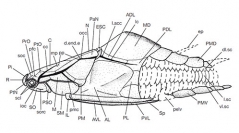

 Geodiversitas
32 (1) - Pages 5-63
Geodiversitas
32 (1) - Pages 5-63The genus Kujdanowiaspis Stensiö, 1942 has long been considered as the archetype of placoderms; hence, it has been often used as outgroup in phylogenetic analyses involving placoderms, or used as a representative of all the placoderms for all early vertebrate works. Nevertheless, there has been no real work on the taxonomy of this genus since Denison (1978). Here we propose a revision of the material of Kujdanowiaspis from the Old Red Sandstone of Podolia (including neurocrania, skull roofs and thoracic armours), together with the description of unpublished specimens of the genus Heightingtonaspis White, 1969. Among the available Podolian material, three species are considered valid: Kujdanowiaspis buczacziensis (Brotzen, 1934), K. podolica (Brotzen, 1934) and Erikaspis zychi (Stensiö, 1945) (K. podolica and K. buczacziensis only differ in size and in the density and size of the tuberculated ornamentation; the dermal plate pattern of E. zychi differs from that of the genus Kujdanowiaspis). The axillar area of the scapulocoracoid of K. podolica is compared with those of an osteostracan "agnathan" and of a non-tetrapod sarcopterygian. In the three cases, the articulation of the pectoral fin is of the monobasal type. An analogy with the embryonic development of the pectoral fin of the actinopterygian Danio rerio (Hamilton, 1822) suggests that the monobasal articulation would correspond to the plesiomorphic condition compared with the multibasal one of the adult actinopterygians and some derived brachythoracid placoderms. The suprasynarcual is a newly identified, chondrified element of the vertebral column, supposed to respond to the height of the median dorsal plate in Kujdanowiaspis podolica.
Placodermi, Arthrodira, "Actinolepida", anatomy, pectoral fin articulation, vertebral column, evo-devo, Lower Devonian, Ukraine